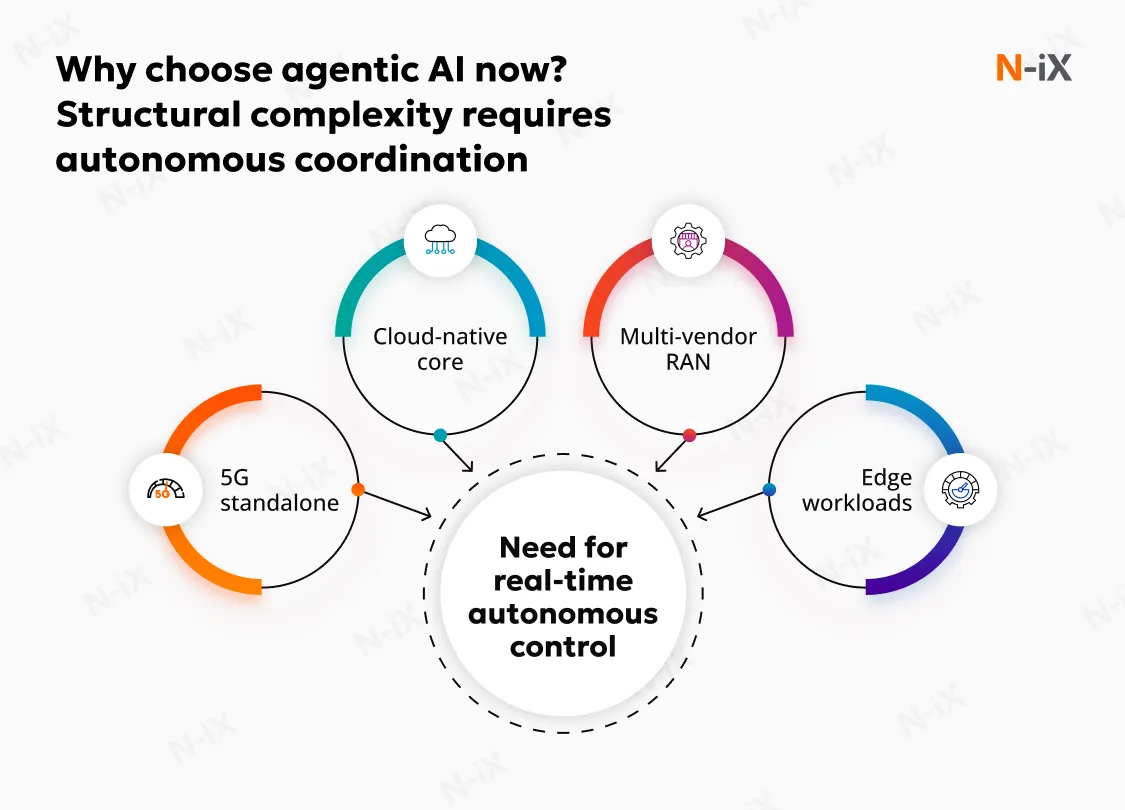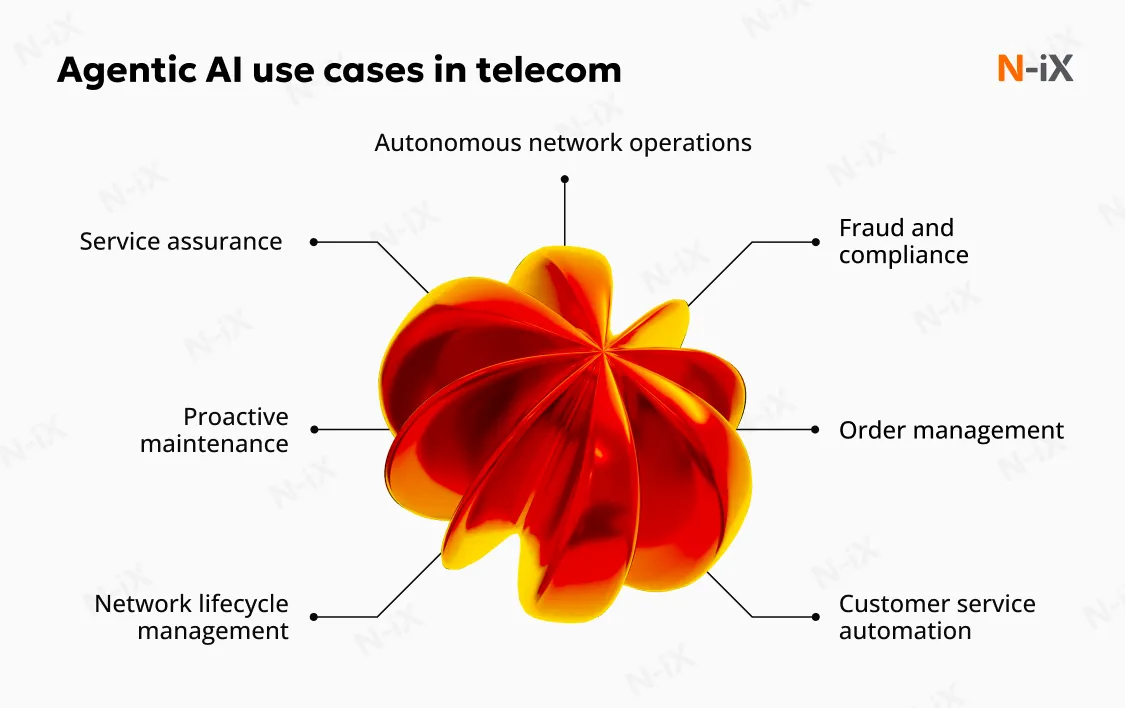What if telecom networks could diagnose performance issues, decide the best corrective action, and implement it automatically, without waiting for manual intervention? Agentic AI brings goal-oriented decision-making into telecom operations.
Multiple specialized agents monitor conditions, interpret intent, coordinate actions, and execute changes across network, customer, and business domains. In telecom, this matters because networks are now too dynamic, distributed, and interdependent for manual or static rule-based operations to sustain reliability or efficiency at scale. Many telecom companies start with AI agent development services to clarify where autonomy makes sense, define agent roles and decision boundaries, and establish orchestration patterns across OSS/BSS and network layers. This provides a structured foundation for safe and scalable deployment.
In this blog post, we examine the most practical and high-impact use cases of agentic AI in telecom in 2026, the measurable business outcomes it enables, and what must be prepared organizationally and technically before deployment.
Why does the telecom industry need to adopt agentic AI in 2026?
Agentic AI introduces autonomous, goal-directed decisioning that allows telecom networks and operations to self-optimize in real time, improving cost efficiency and service performance simultaneously.

Structural complexity requires autonomous control
The shift to 5G standalone, cloud-native cores, multi-vendor radio-access networks (RAN), and the emergence of edge-distributed architectures have significantly expanded operational scope. Networks now change continuously and require real-time coordination across domains. Traditional automation models are designed for static, rule-based optimization and cannot keep pace with dynamic service demands.
Agentic AI for telecom introduces a coordination layer capable of:
- Interpreting network conditions in real time;
- Evaluating trade-offs across performance, cost, and reliability;
- Executing actions directly with optional human oversight.
Operational efficiency and cost containment are strategic priorities
Since ARPU has stayed flat while network investments continue to increase, improving cost efficiency has become essential for operators. Manual operations and human-centered incident management do not scale with network growth. Agentic AI achieved significant outcomes:
- Reduce operational costs by 30-40% [1] via autonomous incident handling, capacity optimization, and fewer manual interventions.
- Lower outage frequency by up to 40% [2] through predictive maintenance and proactive service assurance.
- Accelerate resolution cycles by 70-90%, [3] shifting from post-incident response to continuous self-healing.
Customer experience is emerging as a revenue lever
Customer expectations increasingly center on responsiveness, transparency, and personalization. Standard product packages and reactive support models no longer differentiate. Agentic AI in telecom industry enables individualized service management. It can be done by integrating real-time network telemetry, behavioral data, and contextual triggers into customer engagement workflows.
Observed outcomes include:
- 8-12% ARPU growth [4] through adaptive bundles and usage-aligned offers,
- Up to 80% automated resolution [2] of service inquiries without escalation.
Early adoption generates a compounding competitive advantage
Agentic AI systems learn from each operator's network patterns, service portfolio, customer behavior, and operational constraints. Operators who deploy early benefit from:
- Faster model learning cycles;
- More mature agent behavior policies;
- Greater automation coverage across OSS/BSS domains.
Because improvements compound, a 6-12 month lead in deployment can translate into a multi-year competitive gap, particularly in service agility, cost structure, and CX performance.
The adoption of Agentic AI is a response to structural pressures: network scale, cost economics, and the need for commercial differentiation. Agentic AI manages autonomous, self-optimizing operations and continuous revenue enhancement, outcomes that cannot be achieved through traditional automation alone.
What are the agentic AI use cases in telecom?
The agentic AI use cases in telecom industry below represent the areas where agentic systems already demonstrate material, measurable value.

1. Autonomous network operations
As networks become more distributed, software-defined, and dynamic, the operational workload outpaces what can be managed manually or with rule-based automation. Agentic AI in autonomous network introduces a coordinated, reasoning-based control layer that interprets network conditions, evaluates alternatives, and executes actions aligned to performance, cost, and resilience objectives.
How can the network continuously optimize itself in real time?
Agents interpret performance indicators, forecast demand patterns, and adjust configurations across domains to maintain the stated objective. Instead of static rules, they recalculate optimal actions as network conditions evolve, ensuring continuity under variable load, interference shifts, and mobility events. The Intent Management Function acts as the "policy compass," guiding agentic decision-making toward desired end states rather than procedural steps.
How do we allocate resources when demand surges or traffic patterns shift?
Specialized agents coordinate across packet core, optical transport, and IP layers to rebalance routing paths and allocate compute, bandwidth, and radio resources where they have the most significant effect. The system continuously evaluates performance trade-offs, improving throughput where demand spikes and preventing localized congestion from cascading into wider disruption.
How can RAN performance be optimized without manual tuning?
RAN is particularly sensitive to dynamic environment and demand factors. Agentic AI analyzes interference profiles, user density distributions, and signal degradation patterns to adjust antenna tilt, beamforming parameters, scheduling priorities, and spectrum allocation. It also modulates power consumption based on utilization levels, supporting sustainability goals without sacrificing coverage or reliability.
How do we resolve network issues before they cascade into outages?
When unexpected latency spikes, partial cell outages, or anomalous signaling behavior occur, self-healing agents isolate the affected domain, identify the most probable root cause through multi-layer correlation, and initiate corrective action such as reconfiguration, restart, traffic redirection, or fallback procedures.
2. Service assurance and proactive maintenance
Service assurance shifts from post-event analysis to continuous stability management, where issues are detected, contextualized, and resolved before they escalate. Instead of reacting to alarms and thresholds, agentic systems maintain a persistent, predictive understanding of network health and service impact.
How do we prevent failures instead of reacting to them?
Agentic AI in telecom analyzes streaming telemetry, performance counters, and historical degradation patterns to forecast when components are likely to fail or service quality is trending downward. Maintenance becomes anticipatory: work orders are generated based on risk projections rather than incident occurrence, reducing unplanned outages and emergency dispatches.
A shift to proactive assurance requires correlated telemetry, real-time observability pipelines, and predictive modeling that is domain-aware and operationally grounded. In our work with a global in-flight connectivity provider, we designed a cloud-based data platform that aggregated multi-source performance telemetry and applied predictive models to identify equipment failure patterns up to 20-30 days in advance. Our initiative reduced unnecessary equipment replacements by 75% and enabled scheduled maintenance windows instead of reactive responses. It is the same foundational pattern required before introducing autonomous self-healing agents.
How do we correctly identify the actual cause of service issues?
In complex architectures, symptoms often surface far from the underlying issue. Agents correlate signals across RAN, core, transport, data centers, and cloud workloads to determine the root cause. Instead of presenting alerts in isolation, the system produces a structured diagnosis and a prioritized remediation path, reducing the time and cognitive load required for human operators to interpret noisy event streams.
How do we control alarm storms and reduce noise?
Alarm storms are a well-known challenge in telecom operations. Agentic AI in telecom industry reduces false amplification by clustering related events, suppressing redundant signals, and linking alarms to their causal chain. Incident tickets include context and recommended responses, or the system executes them directly depending on configured autonomy.
How can we ensure SLA commitments are met continuously?
Service commitments are monitored continuously. Agents match real-time KPIs against experience targets and take corrective action before a breach occurs. This is particularly valuable in enterprise connectivity, latency-sensitive workloads, and private network deployments where SLA non-compliance carries contractual penalties.
How do engineers interact with the network more efficiently?
Agentic AI also introduces natural language operations. Engineers can query the network in plain language, "show packet loss trend for region cluster 4 over the past 90 minutes", and the system responds by retrieving the data, running the analysis, and preparing next-step recommendations.
3. Network lifecycle management
Agentic AI in telecom augments lifecycle planning and execution by reducing the complexity of design and on-site deployment workflow.
- AI-driven network planning: Agents evaluate geographic, capacity, and architectural variables to propose coverage plans, cell placements, and topology options. Engineers validate and refine designs rather than manually derive them, compressing planning cycles and reducing misalignment between modeled and real-world performance.
- AI-assisted deployment certification: During rollout and field operations, agents guide technicians, analyze installation imagery or telemetry, verify configuration integrity, and generate compliance reports automatically. Deployment becomes repeatable, auditable, and less dependent on individual expertise.
4. Customer experience and service automation
Agentic AI introduces a different operational model for customer experience: adaptive, continuous, and context-informed. Rather than responding to a request when made, the system maintains an understanding of the customer's history, current state, likely intent, and next best action. Agentic AI use cases in telecom impact customer experience in many different ways:
- Agentic virtual assistants interpret complex requests and complete actions end-to-end rather than simply responding with predefined answers.
- Agents determine when a customer is likely to need additional capacity, experience degradation, or evaluate alternative service plans, and they proactively recommend or implement adjustments. Offers, assistance prompts, and communications are delivered based on real-time relevance.
- A communication agent maintains a unified understanding of the customer's current state, recent interactions, and engagement history. The agent determines appropriate communication, selects the relevant tone and content, and coordinates with backend agents (billing, service provisioning, campaign management).
- A service inquiry agent manages workflows autonomously: validating eligibility, invoking provisioning, updating billing records, confirming completion, and notifying the customer.
- A field assistance agent provides real-time guidance by correlating telemetry, historical service cases, and network topology data.
5. Sales and business support systems (OSS/BSS)
Agentic AI shifts monetization from broad, campaign-based targeting to continuous, context-aware revenue optimization. The system evaluates customer behavior, service experience, network conditions, contract status, and commercial objectives in real time to determine the right action.
How can commercial decisions reflect customer expectations and business priorities?
A business intent management agent evaluates customer value, service experience level, contractual commitments, and operator margin objectives to determine the most aligned commercial action at any moment. Suppose a customer expects price stability while the operator prioritizes network load reduction. In that case, the agent identifies suitable adjustments, such as offering capacity rebalancing or an alternative plan aligned to requirements. Data monetization becomes a negotiation between customer context and business strategy, executed continuously rather than periodically.
How do we tailor product recommendations based on real situational context?
Guided selling agents interpret customer usage patterns, device behavior, travel indicators, or data consumption spikes to recommend offerings that solve current needs. The recommendations are operationally grounded:
- Increase data capacity during peak usage shifts
- Offer roaming packs when a location change is detected
- Suggest Wi-Fi calling setup when indoor coverage challenges emerge
How do we move from static plans to flexible, situation-based offerings?
Traditional product catalogs are fixed. AI agents in telecom enable real-time bundling based on observed conditions. If a customer streams video at an airport, the system may propose a temporary high-throughput pass; if a user begins online gaming, latency-prioritized routing can be offered as a timed add-on. These opportunities are short-lived and context-dependent.
6. Business processes and order management
Monetization depends on operational execution. If orders fail, provisioning stalls, or billing disputes accumulate, revenue leakage offsets strategic gains. Provisioning and activation workflows often span multiple system boundaries. AI agents in telecom validate identity and eligibility, initiate provisioning tasks, verify completion, detect failures, and resolve discrepancies automatically, before the customer encounters a broken activation or billing mismatch.
Billing agents interpret usage metadata, tariff logic, and invoice composition to explain charges clearly and resolve discrepancies autonomously. They initiate adjustments, credits, or upgrade recommendations when patterns indicate dissatisfaction or a mismatch between actual usage and the current plan.
7. Security, fraud, and compliance
Security agents continuously evaluate signaling behavior, traffic flows, authentication anomalies, and device identity patterns. When risk is detected, they isolate affected elements, adjust firewall rules, enforce multi-factor validation, or use shift routing to prevent propagation. The response is immediate, logged, and reversible, reducing dwell time and exposure.
Rather than applying static fraud signatures, agentic systems learn standard behavioral patterns and identify deviations that indicate misuse (SIM-box activity, abnormal routing, suspicious call patterns, insider anomalies). The system intervenes: blocking or restricting activity, opening an audit trail, or requesting customer revalidation. Fraud prevention becomes dynamic, data-driven, and continuously learning.
Read also: Generative AI in telecom: In-depth guide
What should be prepared before implementing agentic AI in telecom?
Agentic AI implementation in telecom requires alignment between strategy, data, operating processes, governance, and talent. At N-iX, we evaluate readiness across four critical dimensions. These decisions and a prioritization model determine where and how autonomy can be introduced safely and with measurable value.
Where should autonomy create quantifiable impact, and why now?
Organizations must define the operational outcomes they aim to improve, such as reduced MTTR, better service assurance stability, or lower field operations cost, and identify the specific workflows where autonomous decision-making is viable. This involves clarifying the role of agentic systems in the operating model, setting measurable success metrics, and determining the boundaries of agent authority. N-iX works with network and operations teams to translate high-level strategy into prioritized use cases, investment justification, and a phased deployment roadmap.
Do we have the data quality and system connectivity required for real-time autonomous reasoning and action?
Agentic AI in telecom industry depends on reliable, correlated, and low-latency data across RAN, core, OSS/BSS, and customer touchpoints. Fragmented or delayed telemetry undermines autonomy. Preparation involves consolidating observability pipelines, standardizing APIs, establishing shared network context models, and enabling real-time orchestration hooks. We support operators in modernizing data flows and integration layers so agents can interpret conditions correctly and act with precision.
For example, we supported a European mobile operator in a cloud-native transformation that migrated their core systems to microservices, implemented a unified data lake, and optimized business intelligence workflows. These improvements enabled near-real-time analytics and significantly reduced reporting delays and infrastructure cost, a necessary precursor for agentic AI's goal-driven orchestration. Achieving foundational maturity allowed the operator to move from reactive OSS/BSS operations toward autonomous decision frameworks.
How do we ensure that autonomous decisions are safe, explainable, and reversible?
Before autonomy is activated, decision guardrails must be explicit. This process includes defining action permissions, auditability mechanisms, human-in-the-loop escalation points, and continuous monitoring of agent behavior. Governance is an operational control system designed to ensure stability. N-iX designs governance models that maintain operational confidence: transparent reasoning, real-time decision logs, and well-defined override paths.
How will teams collaborate with autonomous systems, and what capabilities must evolve?
Agentic AI in telecom requires defined collaboration models between humans and agents, targeted upskilling in AI literacy, and new performance metrics. We help operators introduce practical change models that enable teams to transition into roles that guide, review, and improve autonomous workflows without disrupting day-to-day service delivery.
How this framework translates into implementation phases
What follows is a phased implementation structure that we apply when guiding telecom organizations through this transition. Each phase has a distinct scope, validation goal, integration depth, and performance benchmark. Rather than accelerating scale for its own sake, the progression emphasizes controlled expansion based on demonstrated performance improvements, operational safety, and internal adoption maturity.
|
Phase |
Objective |
Time horizon |
Typical outcome |
|
Pilot domain |
Validate autonomy in one workflow |
10-16 weeks |
Proven operational value |
|
Cross-domain expansion |
Extend autonomy to adjacent use cases |
4-8 months |
Reduced manual load across operations |
|
Scaled autonomy |
Introduce orchestration across multiple agent systems |
12-24 months |
Structural OPEX and reliability gains |
Start a structured pilot for agentic AI in your network
If your telecom organization is evaluating where agentic AI in telecom should be introduced, how to structure the first deployment, or how to ensure governance and operational safety, now is the stage where external expertise has tangible value. We support this transition from the foundation: clarifying the operational domains where autonomy delivers measurable returns, preparing the data and orchestration layers needed for reliable decision-making, and designing governance structures.
A meaningful starting point is a focused readiness assessment or pilot scope definition, a structured evaluation of impact, feasibility, and execution timeline in your specific operational context.
To discuss how agentic AI can be implemented safely and effectively in your network and operational workflows, contact our team. We can begin with a readiness assessment, a targeted use-case pilot, or a strategic architecture review, whichever aligns most directly with your current state and priorities.
FAQ
What is agentic AI in telecom?
Agentic AI in telecom refers to systems that can monitor network and service conditions in real time, interpret what is happening, decide on the most appropriate corrective or optimization action, and execute that action autonomously. Unlike static automation, these systems continuously refine their decisions based on outcomes and changing conditions, supporting resilient network performance and service continuity at scale.
How is agentic AI different from AI automation?
Traditional automation follows predefined workflows and thresholds, improving efficiency but failing to adapt when conditions deviate from expected patterns. Agentic AI evaluates context and reasons for multiple possible actions and adjusts its behavior dynamically without requiring new rules or manual intervention, making it suitable for complex, high-variability telecom environments.
What ROI can telecom companies expect from agentic AI?
Returns are typically measured through reductions in mean time to repair, lower operating costs from fewer manual interventions, improved network uptime, and reduced churn through proactive service quality improvements. Mature implementations can achieve positive ROI within 12-18 months, particularly when deployed in high-cost operational domains such as NOC automation or field support.
Can agentic AI work with existing OSS/BSS systems?
Yes, but it relies on the availability of clear APIs, event streams, and consistent telemetry. In many cases, the first step is enhancing data quality and integration surfaces, allowing agentic systems to observe, analyze, and act without requiring core system replacement.
References
- How agentic AI in telecom can boost efficiency in operations - McKinsey
- Transforming telecom with end-to-end agentic AI - Capgemini
- Scaling the AI-native telco - McKinsey
- The state of competition in telecoms - PWC
Have a question?
Speak to an expert





